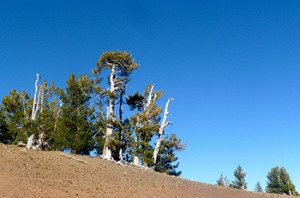The International Union for the Conservation of Nature (IUCN) reports that the latest update to their Red List — a database in which the world’s species are classified according to threat level — includes the first global reassessment of conifers.
In addition to the shelter and food they provide for wildlife, conifers play an important role globally by sequestering carbon. Coniferous forests take three times more carbon out of the air than temperate or tropical forests. Given all the benefits these trees provide, the results of the assessment aren’t too uplifting. While some species have made gains in the 15 years since the last assessment — such as Lawson’s cypress, which went from being classified as vulnerable to near threatened — overall, conifers are in decline. The assessment found that 34 percent of these important trees are threatened with extinction.
The world’s most widely planted pine, the Monterey pine (Pinus radiata), whose decline is largely attributed to pine pitch canker, a fungal disease, is among 33 species of conifer whose status has declined since the previous assessment and among the 34 percent of conifers in danger of extinction. Also among that 34 percent is another tree suffering from a fungal disease: whitebark pine, which is threatened by white pine blister rust. Listed as endangered, whitebark pine is a species of special concern in the American West, where it is a foundation species in the high-elevation ecosystems of the Greater Yellowstone Area. Also listed as endangered is the longleaf pine, a keystone species in the southern United States that supports nearly 600 other species, including the keystone species red-cockaded woodpecker, Bachman’s sparrow and wild turkey.
“Plants are the foundation of life on Earth, providing valuable ecosystem services as well. The recent assessment of conifers shows that many species, including those with known economic and human benefit, are under increasing threat,” says Dr. Thomas Lacher of Texas A&M University in a news release on the assessment. “As IUCN expands the coverage of assessments to more and more plant groups, it will allow conservation actions to focus on protecting the species and ecosystems that support the survival of all life.”
At American Forests, we’re already at work with conservation actions to protect and restore conifers. Our Endangered Western Forests initiative was established to help protect the whitebark pine, not only from white pine blister rust, but also from the exploding mountain pine beetle population brought on by a changing climate. Our Longleaf Pine Restoration project, part of the Alcoa Foundation and American Forests Global ReLeaf Partnership for Trees, is planting 26,000 longleaf pines across 65 acres in South Carolina. You can help, too. Though many conifers are threatened with extinction, we can still fight to save these species upon which so many others depend.

